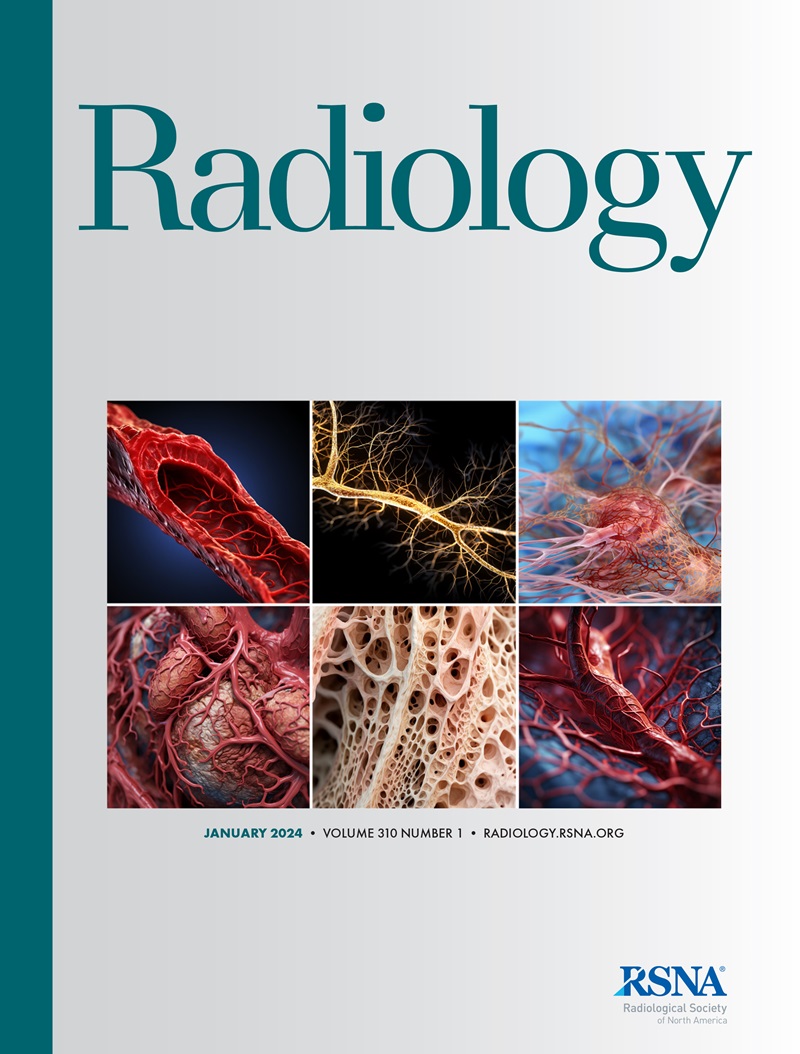Kalina P Slavkova, Ruya Kang, Anum S Kazerouni, Debosmita Biswas, Vivian Belenky, Rhea Chitalia, Hannah Horng, Michael Hirano, Jennifer Xiao, Ralph L Corsetti, Sara H Javid, Derrick W Spell, Antonio C Wolff, Joseph A Sparano, Seema A Khan, Christopher E Comstock, Justin Romanoff, Constantine Gatsonis, Constance D Lehman, Savannah C Partridge, Jon Steingrimsson, Despina Kontos, Habib Rahbar
求助PDF
{"title":"基于mri的多中心原位导管癌风险分层的放射学特征(ECOG-ACRIN E4112试验)。","authors":"Kalina P Slavkova, Ruya Kang, Anum S Kazerouni, Debosmita Biswas, Vivian Belenky, Rhea Chitalia, Hannah Horng, Michael Hirano, Jennifer Xiao, Ralph L Corsetti, Sara H Javid, Derrick W Spell, Antonio C Wolff, Joseph A Sparano, Seema A Khan, Christopher E Comstock, Justin Romanoff, Constantine Gatsonis, Constance D Lehman, Savannah C Partridge, Jon Steingrimsson, Despina Kontos, Habib Rahbar","doi":"10.1148/radiol.241628","DOIUrl":null,"url":null,"abstract":"<p><p>Background Ductal carcinoma in situ (DCIS) is a nonlethal, preinvasive breast cancer for which breast MRI is best suited for accurate disease extent characterization. DCIS is often overtreated, necessitating robust models for improved risk stratification. Purpose To develop logistic regression models using clinical and MRI-based radiomic features of DCIS and to evaluate the performance of such models in predicting disease upstaging at surgery and DCIS score. Materials and Methods This study is a secondary analysis of dynamic contrast-enhanced (DCE) MRI data from the Eastern Cooperative Oncology Group-American College of Radiology Imaging Network, or ECOG-ACRIN, E4112 trial. Primary analysis focused on predicting disease upstaging (<i>n</i> = 295), and secondary analysis focused on predicting DCIS score (<i>n</i> = 174). Radiologist-drawn lesion segmentations and publicly available Cancer Phenomics Toolkit, or CaPTk, software was used to compute 65 radiomic features. Participants were clustered into groups based on their radiomic features (ie, radiomic phenotypes), and principal component analysis was used to summarize the feature space. Clinical information and qualitative MRI features were available. Associations were tested using χ<sup>2</sup> and likelihood ratio tests. Data were split into training and test sets with a 3:2 ratio, and model performance was assessed on the test set using the area under the receiver operating characteristic curve (AUC). Results Data from 297 female participants with median age of 60 years (IQR, 51-67 years) were analyzed. Two radiomic phenotypes were identified that were associated with disease upstaging (<i>P</i> = .007). For predicting disease upstaging, the top three radiomic principal components combined with clinical and qualitative MRI predictors yielded the highest AUC of 0.77 (95% CI: 0.65, 0.88) among all tested models (<i>P</i> = .007), identifying 25% more true-negative (49 of 93 true-negative findings, 53% specificity) findings, compared with using clinical information alone (23 of 93 true-negative findings, 28% specificity). Radiomic models were not predictive of the DCIS score (<i>P</i> > .05). Conclusion In patients with DCIS, combining radiomic metrics with clinical information improved prediction of disease upstaging but not DCIS score. ClinicalTrials.gov Identifier: NCT02352883 <i>Supplemental material is available for this article.</i> ©RSNA, 2025 See also the editorial by Kim and Woo in this issue.</p>","PeriodicalId":20896,"journal":{"name":"Radiology","volume":"315 1","pages":"e241628"},"PeriodicalIF":15.2000,"publicationDate":"2025-04-01","publicationTypes":"Journal Article","fieldsOfStudy":null,"isOpenAccess":false,"openAccessPdf":"","citationCount":"0","resultStr":"{\"title\":\"MRI-based Radiomic Features for Risk Stratification of Ductal Carcinoma in Situ in a Multicenter Setting (ECOG-ACRIN E4112 Trial).\",\"authors\":\"Kalina P Slavkova, Ruya Kang, Anum S Kazerouni, Debosmita Biswas, Vivian Belenky, Rhea Chitalia, Hannah Horng, Michael Hirano, Jennifer Xiao, Ralph L Corsetti, Sara H Javid, Derrick W Spell, Antonio C Wolff, Joseph A Sparano, Seema A Khan, Christopher E Comstock, Justin Romanoff, Constantine Gatsonis, Constance D Lehman, Savannah C Partridge, Jon Steingrimsson, Despina Kontos, Habib Rahbar\",\"doi\":\"10.1148/radiol.241628\",\"DOIUrl\":null,\"url\":null,\"abstract\":\"<p><p>Background Ductal carcinoma in situ (DCIS) is a nonlethal, preinvasive breast cancer for which breast MRI is best suited for accurate disease extent characterization. DCIS is often overtreated, necessitating robust models for improved risk stratification. Purpose To develop logistic regression models using clinical and MRI-based radiomic features of DCIS and to evaluate the performance of such models in predicting disease upstaging at surgery and DCIS score. Materials and Methods This study is a secondary analysis of dynamic contrast-enhanced (DCE) MRI data from the Eastern Cooperative Oncology Group-American College of Radiology Imaging Network, or ECOG-ACRIN, E4112 trial. Primary analysis focused on predicting disease upstaging (<i>n</i> = 295), and secondary analysis focused on predicting DCIS score (<i>n</i> = 174). Radiologist-drawn lesion segmentations and publicly available Cancer Phenomics Toolkit, or CaPTk, software was used to compute 65 radiomic features. Participants were clustered into groups based on their radiomic features (ie, radiomic phenotypes), and principal component analysis was used to summarize the feature space. Clinical information and qualitative MRI features were available. Associations were tested using χ<sup>2</sup> and likelihood ratio tests. Data were split into training and test sets with a 3:2 ratio, and model performance was assessed on the test set using the area under the receiver operating characteristic curve (AUC). Results Data from 297 female participants with median age of 60 years (IQR, 51-67 years) were analyzed. Two radiomic phenotypes were identified that were associated with disease upstaging (<i>P</i> = .007). For predicting disease upstaging, the top three radiomic principal components combined with clinical and qualitative MRI predictors yielded the highest AUC of 0.77 (95% CI: 0.65, 0.88) among all tested models (<i>P</i> = .007), identifying 25% more true-negative (49 of 93 true-negative findings, 53% specificity) findings, compared with using clinical information alone (23 of 93 true-negative findings, 28% specificity). Radiomic models were not predictive of the DCIS score (<i>P</i> > .05). Conclusion In patients with DCIS, combining radiomic metrics with clinical information improved prediction of disease upstaging but not DCIS score. ClinicalTrials.gov Identifier: NCT02352883 <i>Supplemental material is available for this article.</i> ©RSNA, 2025 See also the editorial by Kim and Woo in this issue.</p>\",\"PeriodicalId\":20896,\"journal\":{\"name\":\"Radiology\",\"volume\":\"315 1\",\"pages\":\"e241628\"},\"PeriodicalIF\":15.2000,\"publicationDate\":\"2025-04-01\",\"publicationTypes\":\"Journal Article\",\"fieldsOfStudy\":null,\"isOpenAccess\":false,\"openAccessPdf\":\"\",\"citationCount\":\"0\",\"resultStr\":null,\"platform\":\"Semanticscholar\",\"paperid\":null,\"PeriodicalName\":\"Radiology\",\"FirstCategoryId\":\"3\",\"ListUrlMain\":\"https://doi.org/10.1148/radiol.241628\",\"RegionNum\":1,\"RegionCategory\":\"医学\",\"ArticlePicture\":[],\"TitleCN\":null,\"AbstractTextCN\":null,\"PMCID\":null,\"EPubDate\":\"\",\"PubModel\":\"\",\"JCR\":\"Q1\",\"JCRName\":\"RADIOLOGY, NUCLEAR MEDICINE & MEDICAL IMAGING\",\"Score\":null,\"Total\":0}","platform":"Semanticscholar","paperid":null,"PeriodicalName":"Radiology","FirstCategoryId":"3","ListUrlMain":"https://doi.org/10.1148/radiol.241628","RegionNum":1,"RegionCategory":"医学","ArticlePicture":[],"TitleCN":null,"AbstractTextCN":null,"PMCID":null,"EPubDate":"","PubModel":"","JCR":"Q1","JCRName":"RADIOLOGY, NUCLEAR MEDICINE & MEDICAL IMAGING","Score":null,"Total":0}
引用次数: 0
引用
批量引用

 求助内容:
求助内容: 应助结果提醒方式:
应助结果提醒方式:


